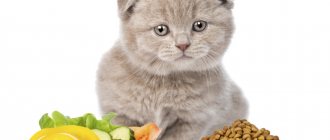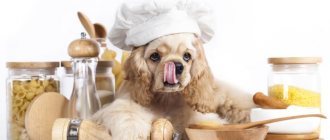Today I want to tell you about how to properly feed a puppy. After all, your fluffy should receive everything he needs for his growing body and grow up strong and healthy.
Of course, you won’t be able to immediately remember all the subtleties of this process. But every day you will gain more and more experience, constantly learn something new and useful. Eventually, you will become well versed in feeding your dog naturally.
And I hope that my advice will help you with this.
Basic rules for feeding a puppy
Here are the main points that every novice dog breeder should know:
- The tail should be fed at the same time.
- Food should be at room temperature.
- Give your baby 10-15 minutes for each feeding. If during this time he has not finished his portion, then it must be put in the refrigerator so that it does not spoil.
- If the puppy has not eaten well, do not increase the prescribed portion at the next feeding. Give as much food as always.
- The food should have the consistency of thick sour cream, not liquid soup.
- It is impossible to load the dog with physical activity immediately after feeding. You need to play active games 1-2 hours after eating.
- A bowl of fresh water should always be there. The puppy should always have access to it.
- Dry food should not be mixed with natural food. If you feed your pet dry food and want to switch it to natural food, read about how to switch your dog to natural feeding.
- For proper formation of the skeleton, it is recommended to feed the four-legged animal from an adjustable stand on which bowls for food and water are installed. Using a tripod, you can adjust the height of the bowl as your puppy grows.
- There is no need to salt food. All foods in nature already contain a certain amount of salt.
- In order to properly feed the puppy, under no circumstances should you replace some foods with others (for example, instead of the required amount of meat, add more cereal). The puppy’s diet must contain all the necessary products and in the right quantities.
- There is no strict feeding schedule. You can replace some equivalent products with others. For example, fish can be replaced with meat, and cottage cheese with sour cream.
- If you are on a milk feeding schedule, but it turns out that there is no sour cream or cottage cheese at home, it’s okay. Offer the tailed meat portion or something else.
- If your baby refuses to eat a particular food, give him what he likes. Take a short break and generally don’t give him anything that makes him turn his nose up. Some time will pass and the appetite for foods that he refused will return.
- Dairy and meat products should not be given at the same feeding.
- If you give your dog raw meat, be sure to freeze it in the freezer for at least 3 days before feeding it to your dog.
- Never give your puppy bones. In the future, you will choose the type of food that is most suitable for your dog. Perhaps it will be a raw food diet. Some types of raw diets allow the consumption of meaty bones. But, you need to teach your baby to chew and not swallow bones whole. In addition, you should know which bones can be given to your dog and which are strictly prohibited.
Diet depending on breed
Regardless of the breed, you need to feed your pet following all the basic rules.
Little ones
A special feature of small breed dogs is their inherent pathology of the heart and blood vessels. Therefore, for puppies of Toy Terrier, Dachshund, Yorkshire Terrier, Spitz, Chinese Crested, Pekingese, Shih Tzu, Bichon Frize and other decorative breeds, it is necessary to additionally give complexes of vitamins and minerals.
The diet should not allow obesity, so the basis should be lean meat. Do not give frequent snacks or overuse treats. For example, the fluffy coat of a Pomeranian Spitz benefits from sea fish.
The diet should provide the need for calcium - cottage cheese and complex mineral supplements.
Average
Medium breed puppies require much more energy and nutritional components for normal growth. For puppies of Shar Pei, Pinscher, Russian and English Cocker Spaniel, French Bulldog, Beagle, Jack Russell, Pug, Corgi and others, premium, holistic dry food is needed.
Natural nutrition should contain large amounts of meat, fiber, calcium and minerals. It is better to choose a special complex depending on the breed. For example, for a spaniel, food that provides a large amount of energy is needed, since the dog is often used for hunting.
Large
Giants such as huskies, German shepherds, Labradors, Alabais, Cane Corso, Rottweilers, Samoyeds, Staffies, pit bulls, Akita Inu, Caucasian Shepherds, Asian Shepherds need increased nutrition.
These dogs have pronounced muscle mass and often have problems with the joints and skeleton. Therefore, a small representative of a large breed must be provided with calcium, proteins, and fiber.
The basis of a natural diet is meat and offal, cereals and boiled vegetables. You need to be very careful about the serving size, since overeating and heavy weight in a puppy can lead to joint problems in an adult dog.
As for mongrel puppies, their diet should be approached based on growth prospects. If it is expected that the baby will grow up to be a serious dog, then the diet is prepared as for a large breed dog.
Photo: pixabay.com
Additional supplements and treats
In addition to basic products, the following additives can be included in the daily diet of a little barbosie:
- Chalk.
- Crushed quail shell.
- Honey (teaspoon per day).
- Fish oil (teaspoon per day).
- Brewer's yeast.
- Bran.
- Laminaria.
- Sprouted cereal seeds.
- From 3 months you can give beef cartilage and chicken necks.
- From 5 months, you can already include beef tripe and other offal in your baby’s diet.
What not to feed
We have noted those products that should become the basis of a puppy’s diet. There are foods that are strictly prohibited from being included in his diet:
- sweets and sweet pastries, bread. Glucose in them will cause fermentation and problems with the gastrointestinal tract, obesity;
- salt and spices;
- tubular bones. They are dangerous due to their fragments, which can pierce the intestines;
- pork, which is a source of trichinosis, which is difficult to cure;
- cabbage and legumes;
- whole milk;
- River fish;
- raw chicken;
- boiled potatoes;
- pasta;
- sausages and anything that contains preservatives.
Photo: pixabay.com
How much food should you give your puppy?
With a natural diet, the daily amount of food consumed by the dog should be approximately 6-8% of the dog's weight. For example, if your pet weighs 10 kilograms, then 7% would be 700 grams.
Feeding a puppy correctly does not mean feeding it to its fullest. Overfeeding is much worse than underfeeding.
You must determine the serving quantity yourself, based on your age and level of physical activity. Appetite can be influenced by many factors. For example, in the summer, when it’s hot, dogs eat much less than in the cold season. Read about what to do if your pet is not eating well.
Knowing whether your puppy is hungry or not is very simple. If the baby licks the bowl after feeding without leaving anything there, this means that the fluffy is not full. In this case, you should increase the portion. Well, if the baby leaves excess porridge in the bowl, then he is completely full.
Before or after a walk
Social skills training begins from the moment a pet arrives in a new family. The sooner the baby understands the rules of behavior in society, the easier it will be for him to adapt to unusual conditions.
Puppies 1 – 2 months old are just getting used to the toilet and will want to relieve themselves after feeding. Select the timing of walks taking into account this need of the growing body and avoid increased activity of your pet on the street. As you get older, walk your dog only before meals. This is an excellent prevention of volvulus and a natural way to increase appetite.
“Patience and more patience!” - this is the motto for the owner of a newborn baby. Until 2 months of age, walk the puppy 6–7 times a day. After feeding, wait 5 - 10 minutes, pick up the baby in your arms and take him to a calm, quiet place where he can do all his business. A grown puppy walks 2 times a day before meals.
After dinner I really want to sleep
Feeding a puppy from one month to a year
At a young age (approximately up to three months), dairy products should be the main ones in the four-legged diet. The puppy should receive 40-50% dairy products from the entire daily diet, 35-50% meat products and approximately 15-25% cereals and vegetables. You need to cook porridge with milk. Kefir, milk, fermented baked milk, yoghurts, cottage cheese and sour cream - all this should be present in the diet of a furry baby. With age, the amount of dairy products should decrease, but meat products, on the contrary, should increase.
After 3 months, the puppy must be fed according to the following scheme: 25-30% dairy products, 50-70% meat, 20% vegetables and 10-15% cereals. Read what foods should be given to your tailed cat, and which ones should absolutely not be given.
All the diagrams below are example diagrams. You can experiment and be imaginative.
It is useful to add mineral supplements to the food (chalk, crushed eggshells, fish oil, dry seaweed).
Feeding plan from one to two months
From three weeks of age, puppies can begin to be offered solid food. New foods should be introduced gradually, starting with one type of protein (for example, beef or veal). Products must be fresh and natural. Once a week, a raw quail or boiled chicken egg.
You can add a teaspoon of vegetable oil to one of the daily feedings to prevent the puppy from becoming constipated. I suggest the following feeding schedule:
- 7.00 – natural cottage cheese, with milk or sour cream.
- 10.00 – boiled (or scalded beef/veal) + some boiled rice.
- 13.00 - milk feeding (milk, cottage cheese, kefir, yogurt, fermented baked milk, sour cream).
- 16.00 – boiled (or scalded beef/beef trimmings) + a little rice.
- 19.00 – milk feeding with the addition of eggs.
- 22.00 - raw scalded meat. It is useful to give raw meat at night so that the dog can sleep better. Look at raw feeding recipes.
If you give your pet raw meat, then do not forget that before feeding it it must be frozen for at least 3 days in the freezer, and scalded with boiling water immediately before feeding.
Feeding plan from two to four months
From 8 weeks, you can gradually introduce new foods, one every 3-4 days. It can be muscular meat of lamb, horse meat, rabbit, fish, poultry. You can also diversify the assortment of vegetables and fruits: cucumber, carrots, pumpkin, zucchini, apples, lettuce and other greens, berries. Vegetables and fruits also need to be introduced once every 3 days, and alternated. By introducing vegetables one at a time, you observe the body’s reaction to a new product, and reject the possibility of an allergy to one or another type of product new to the puppy.
Here is the feeding schedule:
- 7.00 – cottage cheese mixed with milk or sour cream. Or rice porridge cooked in milk + a teaspoon of honey.
- 10.00 – boiled or scalded meat (or poultry) + a little rice + grated carrots (or other vegetables). At first, it is better to simmer the vegetables a little in plain water.
- 14.00 - milk feeding (cottage cheese, sour cream) + fruits (or egg).
- 18.00 – boiled turkey (fish) + grated stewed vegetables and herbs.
- 22.00 - raw scalded (or boiled) meat or fish with vegetables. If your diet allows it, you can add a little boiled cereal to your food.
Feeding plan from four to six months
During this feeding period, begin offering offal to your puppy. Do not forget that the amount of offal should not be more than 10-15% of the animal’s total meat diet.
Feeding schedule:
- 7.00 – milk feeding (cottage cheese, sour cream) + fruits (or egg).
- 12.00 – offal (heart, spleen, liver, kidneys, etc.) + some boiled rice + vegetables + greens.
- 17.00 - milk feeding.
- 22.00 - raw scalded (or boiled) meat or fish with vegetables. If your diet allows it, you can add a little boiled cereal to your food.
Feeding plan from six to ten months
The puppy already eats like an adult dog. Raw meat bones can be included in the diet.
Remember: bones should only be raw. Boiled, stewed or fried bones are strictly contraindicated for animals. The bones must be intact. Under no circumstances should you offer your dog chopped bones. Chicken necks and baby (young) lamb ribs are great to start with.
You can feed it like this:
- 7.00 – cottage cheese mixed with milk or sour cream. Or rice porridge cooked in milk + a teaspoon of honey.
- 14.00 – boiled or scalded meat, fish or poultry + a little rice (if necessary) + grated various vegetables to which the dog is not allergic (carrots, zucchini, pumpkin, cucumber...) + greens.
- 21.00 - raw scalded (or boiled) meat or fish with vegetables. If your diet allows it, you can add a little boiled cereal to your food.
If you offer your pet “soft” bones, at first it is best to feed them during the daytime, and under your supervision.
From 6 months, you can include beef tripe in your baby’s diet, replacing one of the feedings with it. It is recommended to give tripe 2-3 times a week. Check out these beef tripe recipes.
Feeding plan from ten to twelve months
At this stage, dairy products in the diet are significantly reduced. You can feed on this schedule:
- 7.00 – you can alternate between meat and dairy feeding (meat feeding for two days, on the third day meat feeding is replaced with milk feeding).
- 20.00 - raw scalded (or boiled) meat or fish with vegetables. If your diet allows it, you can add a little boiled cereal to your food.
Don't forget to give your puppy boiled chicken or raw quail eggs 1-3 times a week. Fish oil, seaweed and other natural supplements for dogs, vegetables and fruits.
It is not at all necessary to calculate weight down to the milligram and adhere to a strict diet. There is no need to run to the market if there is no pumpkin, zucchini or cucumber in the refrigerator today. The main thing is that throughout the week the dog receives all the necessary vitamins and minerals. You can alternate meat, fish, poultry, and meat by-products at your discretion. But vegetables, herbs, and possibly cereals must be present every day. Several times a week cottage cheese, sour cream, eggs.
Between feedings, you can give your puppy homemade treats and treats. Well, now you can see for yourself that feeding a puppy correctly is not so difficult. You can adjust the feeding order and diet yourself.
Even though our Jack is no longer a puppy, I think this video will be interesting to every novice dog breeder.
Photo gallery
Photo 1. Premium Brit food for puppies
Photo 2. Royal Canin super premium puppy food
Photo 2. Super-premium food for Acana puppies
Prohibited Products
Man has come up with many tasty but harmful products. The dog should not consume:
- sausages and sausage products (both smoked and boiled);
- raw fish and fish products, especially from inland waters;
- fried products of any origin;
- sauces on any basis;
- flour products.
You can offer a sugar cube as a treat, but it is better to avoid sweets.
The mongrel should not be hungry, but excess calories in the diet can lead to weight gain, apathy and obesity. By observing an animal, you can easily determine the feeling of satiety and hunger. Take a closer look at your favorite, and she will tell you herself.
Genetic characteristics of the health of mongrels
Many believe that the mongrel’s body is more resistant to infection than purebred dogs. This is only partly true.
Any dog initially receives immunity through its mother's milk (called clostral milk). If the puppy did not receive immune bodies with milk, for various reasons (for example, the bitch died), then he will not have immunity to some diseases at all. Full milk feeding by the mother is another matter.
On the other hand, mongrels are more stable for the reason that nature itself produces natural selection and the weak die without producing offspring. The third side of stronger health, as many believe, is the absence of closely related mating and this increases the chances of health. The wider the genetic diversity, the healthier the female produces offspring.
Statistical data based on research results in different countries do not support the theory. The life expectancy of mongrels (mongrel dogs) and purebred dogs largely depends on living conditions and feeding, and there is no significant difference.
When choosing a four-legged friend from the street, the owner cannot foresee what the adult dog will be like. A small fluffy ball can be a huge guard dog, or the makings of a large dog can remain only a dream.
Ready-made feed
Ready-made food makes life easier for a dog owner. They have a number of undeniable advantages, but they are not always good quality food that adds health. Prepared feeds are often made from grains. The manufacturer, by introducing synthetic amino acids and vitamins, achieves a high level of proteins and vitamins, but this has nothing to do with natural food.
When buying ready-made food, the owner cannot independently determine the quality. Even laboratory tests cannot always determine the quality, much less the composition of the feed. This provides a wide field for falsification and introduction of all sorts of different things into the feed. The manufacturer (even of expensive food) often deviates from the presented recipe.
Ready-made feed:
- available (available in stores and in different price categories);
- easy to store;
- easy to feed;
- well eaten by dogs.
However, it is undeniable that finished feeds are made at high temperatures. This removes moisture and kills microorganisms. However, biologically active substances are also killed. The food becomes dead. Synthetic added substances cannot fully satisfy the needs of a dog’s body, especially a growing one.
Advantages
Dry food is good if the main thing for the owner is:
- ease of purchasing storage;
- quick feeding (pour it into a bowl and forget it);
- ease of washing dishes (or you don’t have to wash them at all).
If the animal is a friend and family member, and the attitude towards its body is adequate, then the disadvantages of the food are great:
- uncontrollability of components;
- the inability to remove any one nutrient from the diet in case of allergies;
- the presence of stabilizers, preservatives and other substances undesirable for the body.











